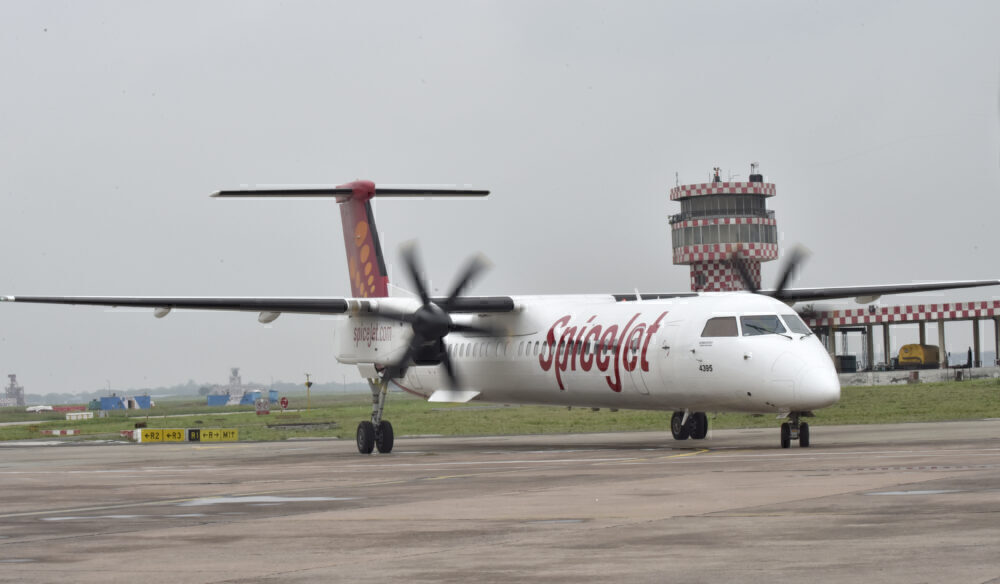Indian low-cost carrier SpiceJet is the second largest LCC in the country after IndiGo. Over the last few years, the budget carrier has seen some fluctuation in its fleet numbers – from a peak of more than 120 airplanes before the COVID pandemic to now less than 100. Like most low-cost airlines, SpiceJet avoids a diverse aircraft fleet for ease of operations and to keep the costs down.

Two aircraft types
SpiceJet is the biggest operator of the Boeing 737 airplane in India and the only carrier to have the 737 MAX series in its fleet. The single-aisle twinjet serves most of its cross-country routes and some short-range international routes such as to the Middle East and South East Asia.
For regional connectivity, the carrier relies on the Dash 8-400 airplanes, with more than 30 in its fleet. For the longest time, SpiceJet has stuck to the two aircraft type model to keep operations smooth and cost effective. Occasionally, its fleet has been peppered with guest appearances from other airplane types such as the Airbus A340, A320 and A321, but their stint with the airline was short lived.
According to ch-aviation, SpiceJet has a total of 97 airplanes:
60 Boeing 737s (5 B737-700, 38 B737-800, 4 B737-900(ER), 13 B737-8 MAX)
32 Dash 8-400
5 converted 737 freighters for its cargo arm SpiceXpress

Fleet reduction
Just a year before the pandemic, SpiceJet was doing fairly well, posting a record profit in the second quarter of 2019. Within a year, the budget carrier had added 42 aircraft to its fleet which also included some 737s of the former full-service carrier Jet Airways. By early 2020, SpiceJet was operating its largest fleet size of 121 airplanes.
In February 2020 due to the grounding of its MAX airplanes and to meet passenger demands, the carrier even wet-leased two Airbus A320s from Bulgaria. At the time, with the uncertainty over MAX’s return and with 737 becoming more expensive to lease, the carrier even considered pivoting towards the A320 family of airplanes for future growth.
However, it was all a different story just a few months later, with COVID-19 restrictions devastating the airline industry. Within a span of months many 737s left the carrier’s fleet, with its total aircraft numbers falling below 100 eventually.

Thankfully, the carrier cashed in on the rising demand for cargo operations during the pandemic, but even that was not enough to pull the airline out of troubled waters.
Boeing 737 MAX
When India banned MAX operations in March 2019, SpiceJet had to immediately ground all 13 MAXs in its fleet. With an average age of just under three years, the carrier’s MAX airplanes had accumulated a little over 6,300 hours cumulatively until the ban.
The carrier is also one of the largest MAX customers in the world, with more than 100 on order and plans to rely on the type for its future growth. Ever since the grounding, the LCC has asked Boeing for compensation in millions.

When the DGCA lifted the ban on the MAX in the last week of August, SpiceJet began preparing the grounded planes to fly again and started training its pilots ahead of flight resumption. However, the carrier missed its scheduled date of October 5th to bring back the MAX and the plane’s return has been pushed back without a new date.
Clearly, SpiceJet has taken an enormous hit from the COVID pandemic. With a reduction in fleet size and mounting losses, the carrier has even brought down its winter flight capacity by 30% compared to 2019. Here’s hoping for better days for the carrier as the aviation world begins to pick up the pieces in a post-COVID world.
from Simple Flying https://ift.tt/3w2tkuk
via IFTTT
Comments
Post a Comment